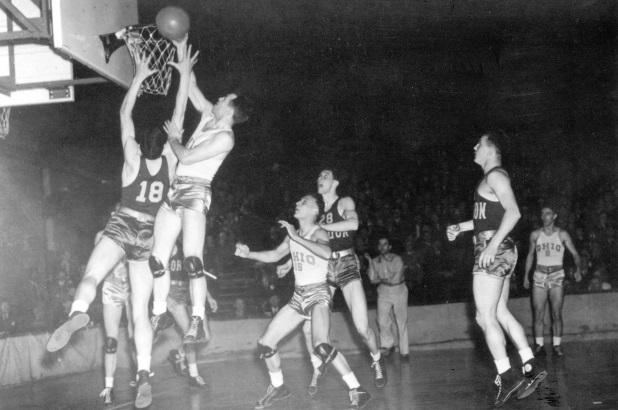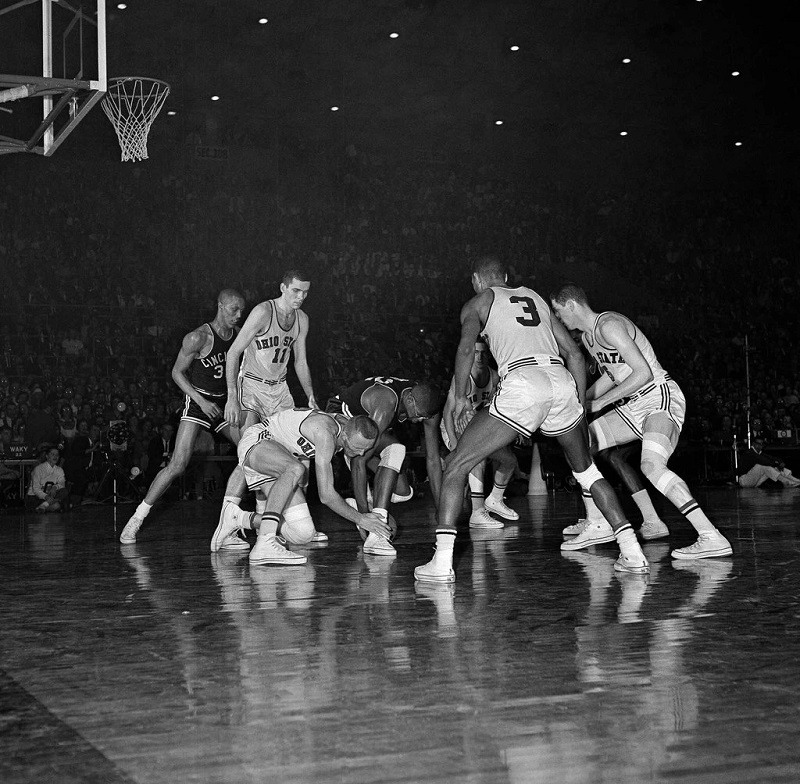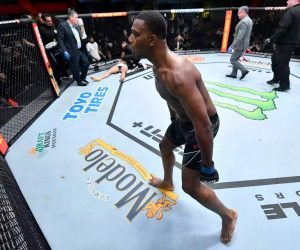The OG List returns! With March Madness upon us, we compiled a complete list of the NCAA men’s college basketball champions and winners, starting with 1939 and leading all the way up to the present day one-and-done era.

The inaugural NCAA basketball tournament in 1939 included eight teams, with six conference champions and two independents earning invites. Brown, Ohio State, Villanova, and Wake Forest met in Philadelphia for the East Regional. Oklahoma, Oregon, Texas, and Utah State battled in San Francisco for the West Regional. Oregon won the West, Ohio State won the East and both teams hopped on trains and met in Chicago for the championship game, hosted at Northwestern University.
The Oregon Webfoots defeated Ohio State 46-33 to win the first NCAA basketball championship on March 27, 1939. March Madness was born.
UCLA holds the record with 11 college basketball championships, including ten with John Wooden. Kentucky won the second most titles in NCAA history with eight college basketball championships.
March Madness Quick History
The term March Madness originated in the late 1930s by an Illinois state high school basketball official to describe their state-wide tournament. It became a part of everyday sports vernacular when CBS announcer Brent Musberger used “March Madness” during his coverage of the tournament in 1982.
In its earliest days, the NCAA tournament played second fiddle to the National Invitational Tournament (NIT), which started one year earlier in 1938. Top teams preferred to play at the NIT in front of the big crowds at Madison Square Garden in New York City. During its heyday in the 1950s, college basketball was a bigger draw than the NBA. It’s hard to imagine that the NIT was once the biggest event in all of basketball.
As the NCAA grew more powerful, thanks to a lucrative television contract with CBS Sports, the men’s college basketball tournament finally became the primary tournament for the elite programs in college basketball. These days, the NIT is akin to a second-chance tournament and reserved for teams that bubbled the March Madness tournament.
The NCAA tournament began with eight teams. The NCAA expanded the brackets to 16 teams in 1951.
In 1975, the tournament doubled to 32 teams.
In 1985, the tournament doubled in size once again and expanded to 64 teams, or what we know as the modern bracket.
A 65th team was added to the bracket in 2001, and the first play-in game was born.
In 2011, the NCAA expanded the field to 68 teams that included four play-in games.

Early Days: Pre-War and Post-War 1939 to 1950
During the infancy of the March Madness tournament, teams from the Pacific Coast Conference – now known as the modern-day Pac-12  – and Big Ten dominated the scene and won the first four titles. Oregon and Stanford were champions from the PCC, while Indiana and Wisconsin were the Big Ten’s first March Madness winners.
During WWII, the NCAA continued to host their basketball tournament without any interruptions. Wyoming won their first and only college basketball title in 1943.
Dartmouth were runner-ups twice during the war years with a second-place finish in 1942 and 1944.
Bob Cousy was a freshman on the Holy Cross team that defeated Oklahoma to win the 1947 championship.
| LIST of MARCH MADNESS CHAMPIONS, 1939 to 1950 |
| WINNERS | RUNNER-UP |
| 1939 | Oregon | Ohio State |
| 1940 | Indiana | Kansas |
| 1941 | Wisconsin | Washington State |
| 1942 | Stanford | Dartmouth |
| 1943 | Wyoming | Georgetown |
| 1944 | Utah | Dartmouth |
| 1945 | Oklahoma A&M | NYU |
| 1946 | Oklahoma A&M | North Carolina |
| 1947 | Holy Cross | Oklahoma |
| 1948 | Kentucky | Baylor |
| 1949 | Kentucky | Oklahoma A&M |
| 1950 | CCNY | Bradley |
Oklahoma A&M, now known as Oklahoma State, made NCAA history as the first team to win multiple championships and the first team to secure back-to-back titles.
Kentucky, led by the one and only Adolph Rupp, won back-to-back titles in 1948 and 1949.
In 1950, City College of New York became the first and only team to win the NCAA and NIT in the same season. CCNY’s program imploded shortly after when players were bribed by the mafia in a point-shaving scandal.

Sweet 16 Expansion: 1951 to 1963
Blue blood programs like North Carolina, Indiana, Kansas, and Kentucky won titles during this era, which helped establish their pedigree. Indiana added a second title in 1953. Kentucky added a third title in 1951 and a fourth championship in 1958.
The Kansas Jayhawks won their first championship in 1952. The North Carolina Tar Heels won their first title in 1957 in a triple-overtime game that’s often considered one of the all-time greatest games in March Madness history. Frank McGuire coached North Carolina to a one-point victory over Wilt Chamberlain and Kansas.
| LIST of MARCH MADNESS CHAMPIONS, 1951 to 1963 |
| WINNERS | RUNNER-UP |
| 1951 | Kentucky | Kansas State |
| 1952 | Kansas | St. John’s |
| 1953 | Indiana | Kansas |
| 1954 | La Salle | Bradley |
| 1955 | San Francisco | La Salle |
| 1956 | San Francisco | Iowa |
| 1957 | North Carolina | Kansas |
| 1958 | Kentucky | Seattle |
| 1959 | California | West Virginia |
| 1960 | Ohio State | California |
| 1961 | Cincinnati | Ohio State |
| 1962 | Cincinnati | Ohio State |
| 1963 | Loyola Chicago | Cincinnati |
After the NCAA expanded March Madness to 16 teams, La Salle and Loyola Chicago were the only other small schools to win the championship in the late 1950s and early 1960s.
Bill Russell led the San Francisco Dons to back-to-back championships in 1955 and 1956.
Cincinnati, led by the mighty Oscar Robertson, notched back-to-back titles in 1961 and 1962. They defeated John Havlicek and Ohio State both times in historic games that people still talk about that intense rivalry down in Ohio.

UCLA Dynasty: 1964 to 1975
John Wooden, the Wizard of Westwood, guided the UCLA Bruins to ten championships between 1964 and 1975. UCLA won seven straight championships between 1967 and 1973. The Bruins picked off seven different challengers  –  Dayton, UNC, Purdue, Jacksonville, Villanova, Florida State, and Memphis State  –  in the championship game during their record-breaking stretch.
Kareem Abdul-Jabbar, then known as Lew Alcindor, won three championships with UCLA between 1967 and 1969. If the NCAA allowed freshman to play college basketball, there’s a chance that UCLA would’ve won in 1966 and secured 10-straight titles for UCLA and Wooden.
| LIST of MARCH MADNESS CHAMPIONS, 1964 to 1975 |
| WINNERS | RUNNER-UP | |
| 1964 | UCLA | Duke |
| 1965 | UCLA | Michigan |
| 1966 | Texas Western | Kentucky |
| 1967 | UCLA | Dayton |
| 1968 | UCLA | North Carolina |
| 1969 | UCLA | Purdue |
| 1970 | UCLA | Jacksonville |
| 1971 | UCLA | Villanova |
| 1972 | UCLA | Florida State |
| 1973 | UCLA | Memphis State |
| 1974 | NC State | Marquette |
| 1975 | UCLA | Kentucky |
During the UCLA dynasty, only two other teams won March Madness. Texas Western, now UTEP, defeated Adolf Rupp’s Kentucky squad in 1966. It also marked the first time in March Madness history when five black players from the same team, Texas Western, started in an NCAA championship game.
The North Carolina State Wolfpack, led by Norm Sloan, won their first March Madness title in 1974 when they defeated Al McGuire’s Marquette.

Expansion to 32 Teams: 1975 to 1984
UCLA won their last title of their John Wooden dynasty in the first year that the NCAA expanded March Madness to a field of 32 teams. At that point, over the next ten years, there were no repeat champions.
In 1977, Al McGuire finally won a championship with Marquette. It also marked the first time a pair of brothers won March Madness titles. His older brother, Frank McGuire, won North Carolina’s first title 20 years earlier.
During the late 1970s and early 1980s, several magical moments occurred in March Madness, including the epic 1979 Final Four when Magic Johnson and Michigan State defeated Larry Bird and Indiana State to win the championship.
| LIST of MARCH MADNESS CHAMPIONS, 1975 to 1984 |
| WINNERS | RUNNER-UP | |
| 1975 | UCLA | Kentucky |
| 1976 | Indiana | Michigan |
| 1977 | Marquette | North Carolina |
| 1978 | Kentucky | Duke |
| 1979 | Michigan State | Indiana State |
| 1980 | Louisville | UCLA |
| 1981 | Indiana | North Carolina |
| 1982 | North Carolina | Georgetown |
| 1983 | NCÂ State | Houston |
| 1984 | Georgetown | Houston |
In 1982, North Carolina defeated Georgetown to win the championship in a game loaded with future Hall of Famers including Michael Jordan, James Worthy, and Patrick Ewing.
In 1983, fans witnessed a true Cinderella story when North Carolina State pulled off one of the greatest upsets in collegiate sports history. Jim Valvano led the NC State Wolfpack to a stunning last-second victory over Houston during one of the craziest runs in March Madness history.
Modern Bracket of 64: 1985 to 2005
In 1985, the NCAA expanded March Madness to include 64 teams, but despite the expanded pool, teams from major conferences continued to dominate. The days when a small school like Holy Cross or Loyola Chicago could win a championship were gone forever.
The Big East dominated college hoops in the early 1980s, including the time they sent three teams to the 1985 Final Four. Villanova needed a perfect game to defeat Big East rival Georgetown in the 1985 championship game, and the Wildcats pulled it off.
In 1990, Jerry Tarkanian and the Runnin’ Rebels of UNLV were an unstoppable force en route to their only NCAA championship in 1990.
| LIST of MARCH MADNESS CHAMPIONS, 1985 to 2005 |
| MARCH MADNESS WINNERS | RUNNER-UP | |
| 1985 | Villanova | Georgetown |
| 1986 | Louisville | Duke |
| 1987 | Indiana | Syracuse |
| 1988 | Kansas | Oklahoma |
| 1989 | Michigan | Seton Hall |
| 1990 | UNLV | Duke |
| 1991 | Duke | Kansas |
| 1992 | Duke | Michigan |
| 1993 | North Carolina | Michigan |
| 1994 | Arkansas | Duke |
| 1995 | UCLA | Arkansas |
| 1996 | Kentucky | Syracuse |
| 1997 | Arizona | Kentucky |
| 1998 | Kentucky | Utah |
| 1999 | UConn | Duke |
| 2000 | Michigan State | Florida |
| 2001 | Duke | Arizona |
| 2002 | Maryland | Indiana |
| 2003 | Syracuse | Kansas |
| 2004 | UConn | Georgia Tech |
| 2005 | North Carolina | Illinois |
Coach K put Duke on the map with back-to-back titles in 1991 and 1992. Duke became the first team to win consecutive championships since UCLA’s dynasty ended in 1975.
North Carolina won its third championship and second under Dean Smith in 1993.
In 1995, UCLA added their first championship won by a non-Wooden team. It marked championship banner #11.
Connecticut, aka UConn, was a huge underdog and pulled off a major upset over Duke in 1999 to win their first championship.
21st Century One and Done Era: 2006-Present
In 2005, the NBA passed the “one-and-done” rule which prevented high school players from heading directly to the NBA. Players were forced to spend one season playing college hoops, or they could head overseas for their gap year abroad. As a result, the top recruits from high school headed to college with the sole intention of playing one season before bouncing.
Programs like Kentucky became a factory for the NBA. However, even though they often had numerous future NBA stars on the roster every season, Kentucky won only one title in the one-and-done era.
| LIST of MARCH MADNESS CHAMPIONS, 2006 to NOW |
| MARCH MADNESS WINNERS | RUNNER-UP | |
| 2006 | Florida | UCLA |
| 2007 | Florida | Ohio State |
| 2008 | Kansas | Memphis |
| 2009 | North Carolina | Michigan State |
| 2010 | Duke | Butler |
| 2011 | UConn | Butler |
| 2012 | Kentucky | Kansas |
| 2013 | Louisville | Michigan |
| 2014 | UConn | Kentucky |
| 2015 | Duke | Wisconsin |
| 2016 | Villanova | North Carolina |
| 2017 | North Carolina | Gonzaga |
| 2018 | Villanova | Michigan |
| 2019 | Virginia | Texas Tech |
| 2020 | N/A | N/A |
| 2021 | Baylor | Gonzaga |
Florida, led by Billy Donovan, won back-to-back titles in 2006 and 2007. Florida became only the second team since the UCLA dynasty to win consecutive titles.
Although numerous mid-major teams found success in March Madness with deep runs into the Final Four, those schools could not get over the hump. Major conferences dominated March Madness. Coach K added two more titles with Duke. Roy Williams won two more championships with North Carolina.
Butler came close to breaking the mid-major hex. Twice. The Bulldogs, led by Brad Stevens, were the runner-up in back-to-back seasons in 2010 and 2011.
In 2020, for the first time since its inception, March Madness was cancelled due to the pandemic and outbreak in the US.

Who Won the Most College Basketball Championships?
A total of 35 different colleges and universities won the NCAA basketball championship. Only 15 schools won the college basketball championship more than once. Obviously, no one has come close to catching UCLA and 11 championships, but Kentucky won eight that were spread out through different eras.
North Carolina won six championships under three iconic coaches: Frank McGuire (1), Dean Smith (2), and Roy Williams (3).
| MARCH MADNESS: MOST CHAMPIONSHIPS WON |
- UCLA 11
- Kentucky 8
- North Carolina 6
- Duke 5
- Indiana 5
- UConn 4
- Kansas 3
- Villanova 3
Coach K won five titles with Duke since 1991, and if you ask him, he’s not done yet.
Indiana won early March Madness titles in 1940 and 1953. Mercurial head coach Bobby Knight won three championships (1976, 1981, 1987) before the school grew tired of his antics.
Connecticut won four titles. To put that impressive feat into context, only five schools won more. Kansas and Villanova won three each.
Check out more OG Lists.











